Many companies have big plans for their knowledge management systems, but their efforts suddenly go down the drain when they start implementing them.
There are countless reasons why knowledge management efforts fail. Some of them are easily overlooked as it can be hard to believe that they could be the root cause of the unsuccessful launch.
That’s why in this article, we have listed the nine most challenging pitfalls that stand in the way of establishing a winning knowledge management system. Let’s see what they are!
Identifying Knowledge Gaps
As technology develops at an accelerated pace, employees have to keep acquiring new skills throughout their careers.
As a result, many employees are required to do work for which they were not hired or trained to do, while others can experience difficulties coping with new job requirements.
A survey conducted by McKinsey shows that 43% of respondents report their company is facing skill gaps, while another 44% claim they expect such gaps to occur in the next five years.
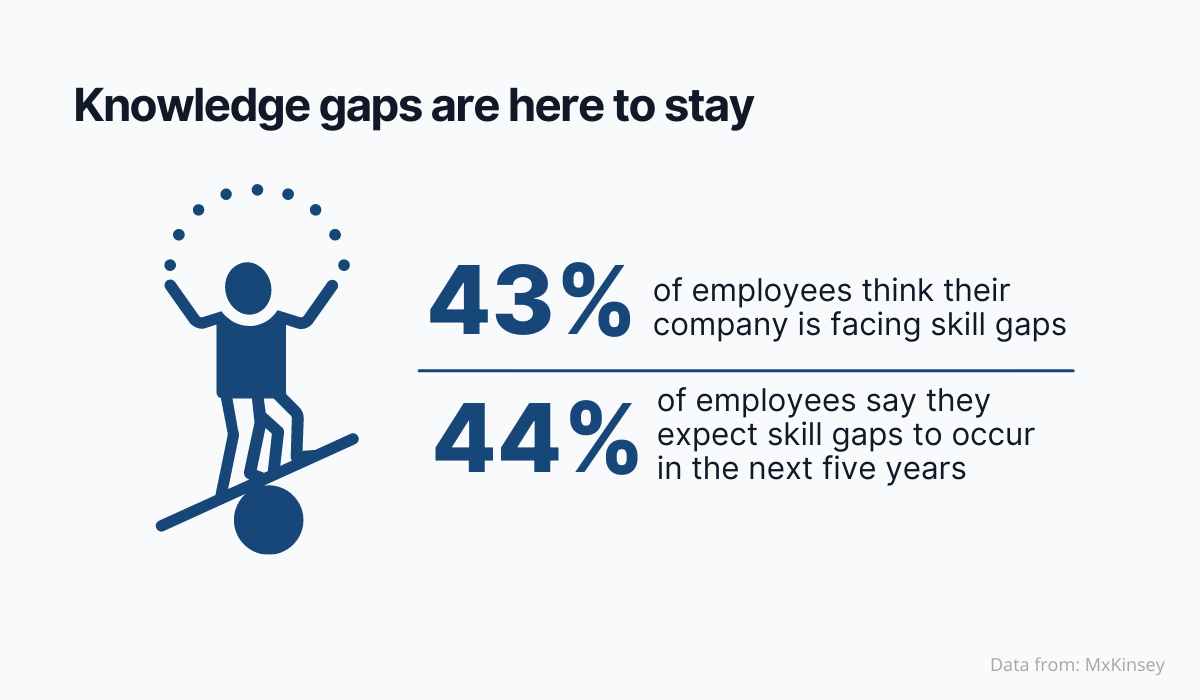
But as knowledge gaps are largely intangible, and there is no magic formula for identifying the employees’ weak spots, many companies use technology as a helping hand.
For example, Disprz is an AI-based platform that helps companies create skills maps that provide a clear picture of where employees show a need for improvement.

With the highly customized Skill scores and Role fitment scores, the software benchmarks employees' current skills in percentages, finds the weak spots, and outlines areas in which they should improve.
Once found, the next part of this challenge is bridging these knowledge gaps, perhaps through the wide array of online courses that exist in the market today.
For instance, with a subscription to Udemy, Skillshare, or any other learning platform, employees can take various courses and classes and master new skills.

For example, Udemy currently offers 183,000 online video courses from nearly every industry, which means thousands of possibilities for the employees to bridge knowledge gaps in their day-to-day work.
Gaps in knowledge usually result in reduced employee productivity. Therefore, identifying and overcoming them should be one of your top priorities.
Maintaining Information Relevance
Companies face massive changes not only in terms of knowledge gaps, but also in business processes and operations. As a result, information in internal documentation can become outdated overnight.
For example, not so long ago, Adobe Flash was a popular tool for playing games, videos, and audio within web pages.
But the rise of HTML5 meant the quick demise of the software by early 2021, inspiring people to say their last goodbyes to it on social media.

This is just one example of how quickly once-dominant technologies and work processes we’re accustomed to can become obsolete.
But let’s look at a more recent example to clarify the matter further.
When the pandemic took hold, companies accelerated the digitization of their internal operations by three to four years. And many of them shifted to remote work entirely.
As a result, a lot of the knowledge and culture that was, up until then, a part of the office atmosphere suddenly needed to be preserved in documents and knowledge bases so it could be accessed by remote workers.
Luckily for Toptal, they didn’t have to overcome such challenges.
As one of the pioneers in exclusively remote work, with the onset of the pandemic, they didn’t just create a playbook dedicated to working off-site but also made it public so other companies could learn from their best practices.
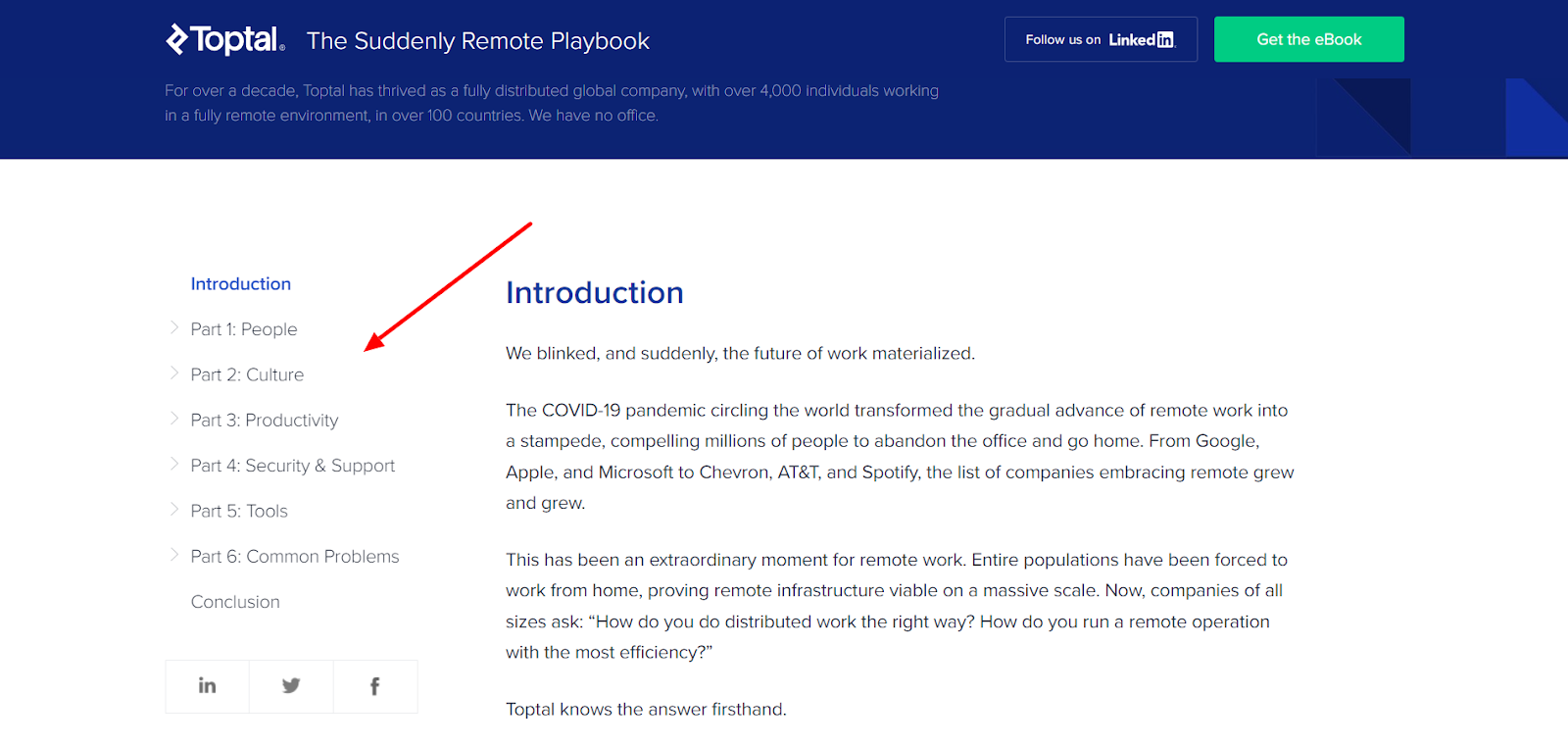
From people and culture to security and best tools, the playbook covers almost every aspect of remote work, thus becoming a treasure trove of incredibly accurate, factual, and valuable information for their employees and other companies alike.
The secret to this kind of success is keeping your knowledge base flexible and updating it as soon as the need arises.
That’s why it’s a good idea to assign a person who will be in charge of regularly checking the knowledge base and revising its content. Or you can simply “hire” Daniel the Manual Spaniel to do this job for you.

As you can see from the picture, whenever a certain page is due for review, a bot named Daniel the Manual Spaniel sends the reminder. The best part is that Daniel is open-source, so everyone can use the bot in their workflow.
Keep in mind that developers boost their productivity by 50% when documentation is up-to-date, detailed, and reliable. So it’s worth the effort to keep your knowledge base relevant because it can do wonders for your employees too.
Unsupportive Culture
Although today we're constantly bombarded with information, when it comes to the workplace, sharing information is not as common as it should be.
In fact, a Nintex study revealed that 43% of respondents experienced issues with document sharing. In fact, document sharing holds second place on the list of the most ineffective document management processes.
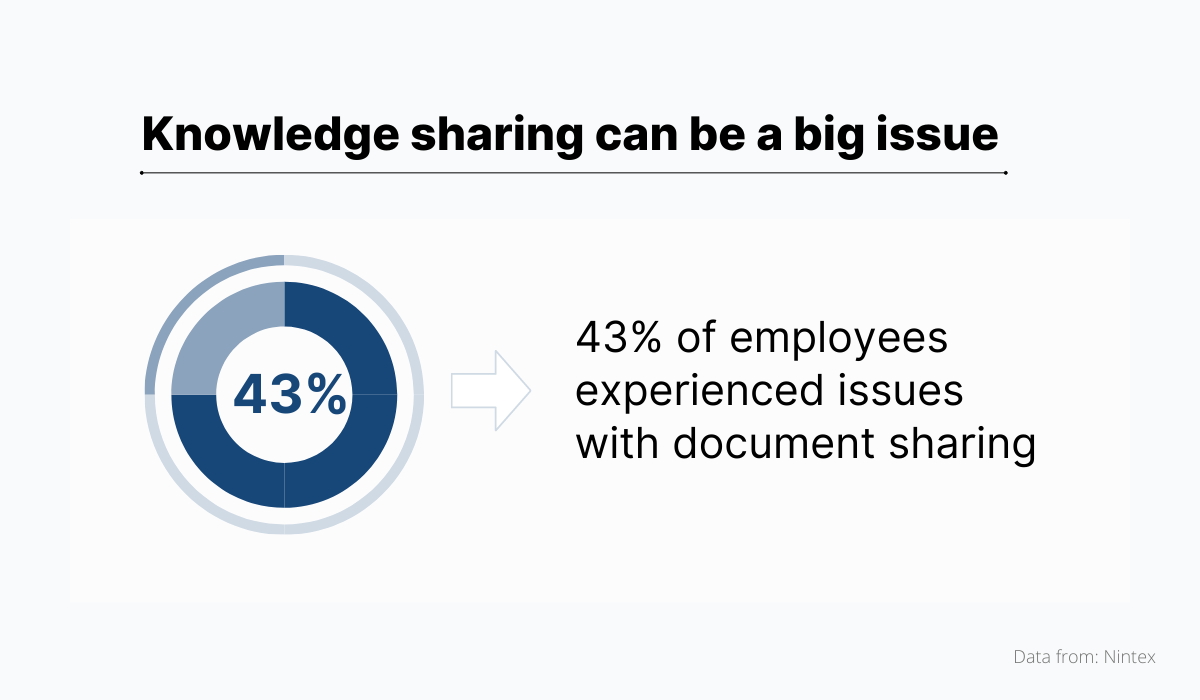
The truth is that employees often see themselves as competition and hoard knowledge as they fear losing their competitive edge if they share their insights with others.
The only way companies can resolve this issue is to focus on building a strong knowledge-sharing culture.
Easier said than done?
It doesn't have to be, as we can see in the example from Keysight Technologies. To create a knowledge-sharing culture, they've redesigned their Keysight Pulse intranet, which eventually became one of ten winners of the 2021 Intranet Design Annual award.

As soon as the redesign was finished, they encouraged employees to share articles, comment on blog posts, and offer suggestions for improvement.
To build team spirit even further, they invited them to engage in fun activities, share their videos or participate in a monthly photo contest. And the employees responded.
During the pandemic, teams from different parts of the world posted videos of themselves cooking together, singing songs, or sharing holiday wishes.

One team even created a music video to lift everyone's spirits when the company had to transition to remote work because of COVID-19. What a great way to create an engaging company culture!
And in such a friendly environment, employees won’t hesitate to share their knowledge with co-workers.
Remember, creating a knowledge-sharing culture can be challenging. Still, if you put a bit of fun and games into the equation, this task will soon become more manageable.
Lack of Purpose
The purpose of the knowledge management system is to share information and experiences with others in the company and ensure that everyone can access them whenever they need them for their work.
But what happens when you have a knowledge base in place but haven’t communicated its purpose?
Well, your employees might be reluctant to use it because they don’t understand its value. And knowledge sharing may never get off the ground as a result.
There are many ways to convey the purpose to the employees, and the example from TRADOC speaks volumes about it.
The purpose of their knowledge management process is, as you can see from the tweet, all about sharing information and connecting people.
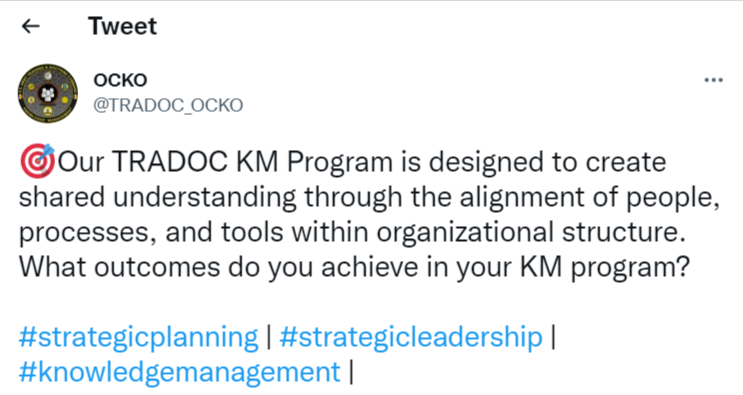
Once they revolutionized their processes by implementing a knowledge management system, they continued to emphasize its importance throughout the organization.
In their effort to build an environment that truly understands the value of exchanging knowledge, ideas, and expertise, they even went one step further and created a documentary.

The documentary paints a clear picture of how knowledge management has helped them to centralize information and improve operations.
But the real goal is to convey a message that it’s everyone’s duty to participate in knowledge sharing, as it will improve their job and the performance of the entire organization.
Or, as general Paul E. Funk II concisely describes the process of knowledge management in one of the last scenes of the documentary:
“It is not a function performed by a few people in HQ; it's part of everyone's job."
Remember, good knowledge management will boost the productivity of your employees, as well as enable them to solve problems faster, and make better decisions.
It would be a pity if all this went to waste simply because the purpose wasn’t clearly communicated to the workforce.
Poor Knowledge Management Implementation
Rushing to quickly take advantage of all the benefits, many companies start implementing a knowledge management system without thinking about how their employees will adopt new tools and adapt to the ways of working.
Implementing a knowledge management system can be a slippery slope for many companies if they don't address the following dangers:
- Unfamiliarity with software
- Lack of incentives for sharing knowledge
- Incomplete or confusing documentation (surveys found this to be the biggest problem encountered in open-source software development)
When it comes to incomplete documentation, we have addressed this topic in one of the previous sections of this article, so we will discuss the other two bullet points from the list–incentives and software.
First, you can set the stage by offering incentives and rewards to employees who participate in your knowledge management. Even a simple thank you note will encourage desirable behavior like sharing knowledge.

Next, you need to make sure employees are trained on how to use the knowledge management software and offer them tutorials on how to tackle its features and capabilities if they have further questions.
For instance, many companies that already use Confluence as a project collaboration tool have started using it for knowledge management as well. Part of the reason for this is because Confluence has a YouTube channel with 125 videos about how to use the software.

With these short tutorials, employees can get the hang of Confluence in no time. And when they get familiar with it, chances are that they will use it regularly in their day-to-day work, meaning the implementation of the system will be a major success.
Remember, with the right tools and activities, you can overcome all obstacles and experience the benefits of an outstanding knowledge management system in no time.
Making Information Easy to Find
Many of our previous articles emphasize easy access to information as one of the most important aspects of good knowledge management systems.
That’s because the statistics are relentless: employees spend almost 20% of their working hours searching for the information they need to do their job.

As this has a profound effect on their productivity, making information easy to find should be one of the companies’ top priorities.
One of the ways companies can rise above this challenge is to choose documentation software that has advanced searching possibilities.
For example, our documentation software, Archbee, has been the first choice of many companies thanks to its unique search options.
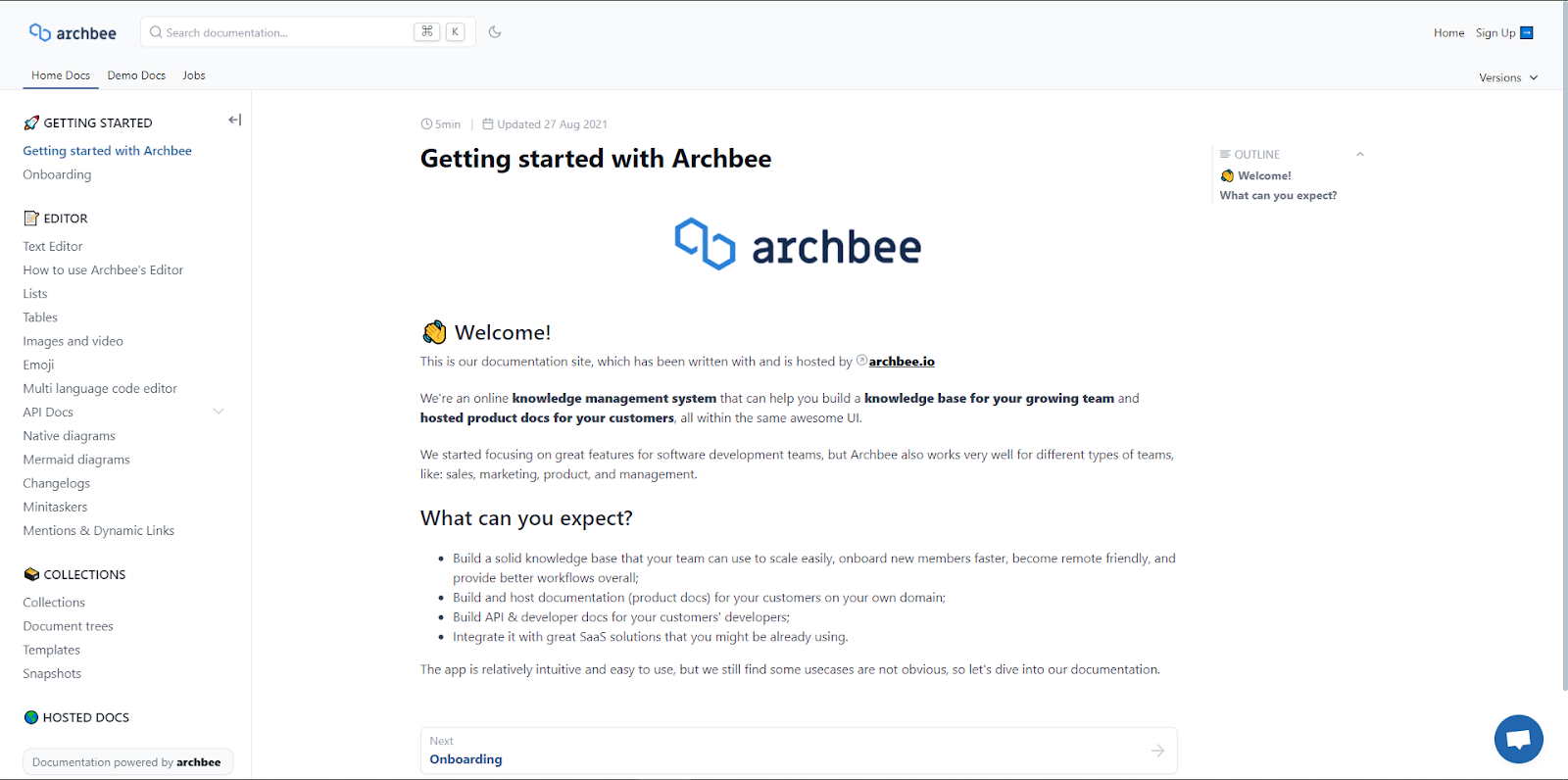
Categories on the left side systematize topics. At the top of the page, there is a search bar that enables employees to search through the entire internal documentation or only specific folders in no time. And a sticky table of contents on the right side allows scanning the document's content before reading it.
Plus, Archbee has a Search Analytics feature that notifies admins what the most sought-after content in the knowledge base is.
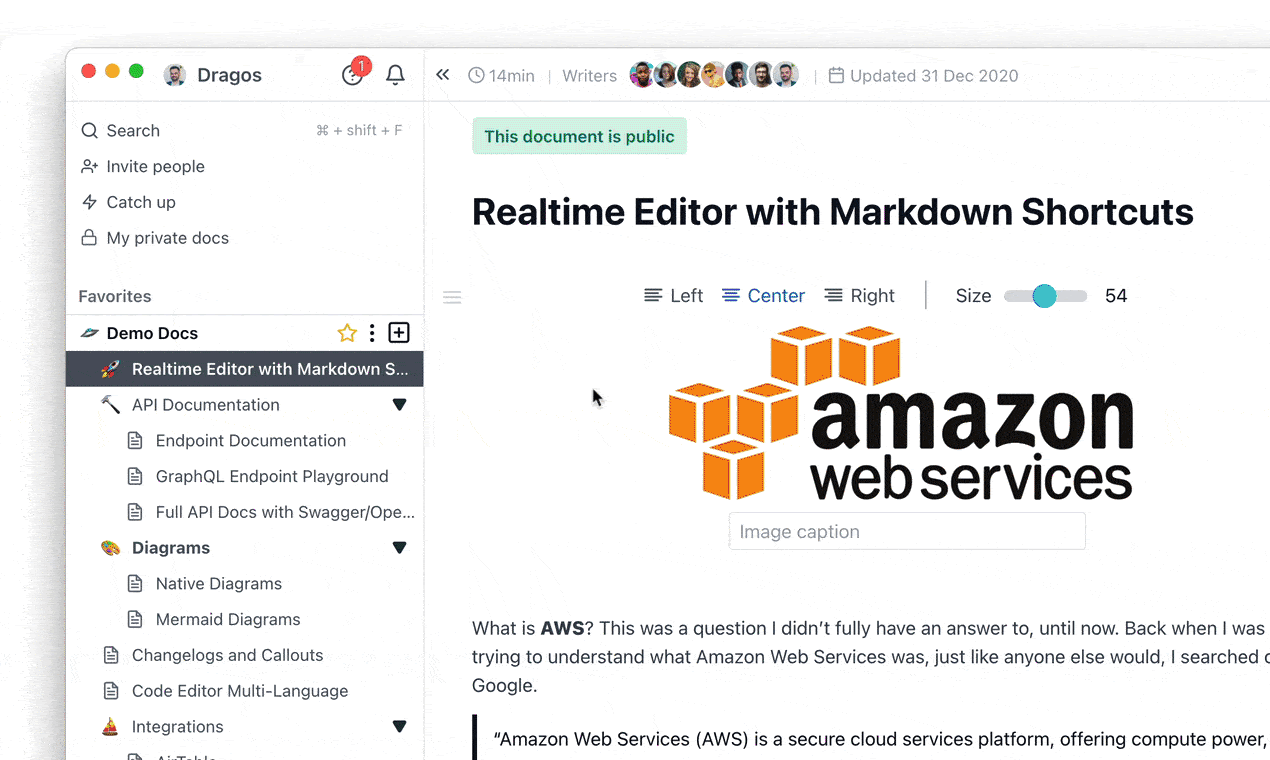
That way, admins can determine what kind of content employees find interesting and helpful, thus enabling them to decide about the topics they will cover in future articles.
Quality documentation software with excellent searchability helps team members find the information quickly, so they don't have to be a part of the 20% statistics anymore.
As this saves them a lot of time and makes them more productive, it's worth investing in software that makes finding information a breeze.
Lack of Customization
Many companies think creating a knowledge base is as simple as choosing a template and filling it with their information.
But the truth is quite different. No magic wand will miraculously create a knowledge base tailored to your company.
Creating and implementing a knowledge management system is a complex task that involves several stages of production, as you can see from the picture below, and there is no room for one-size-fits-all solutions.
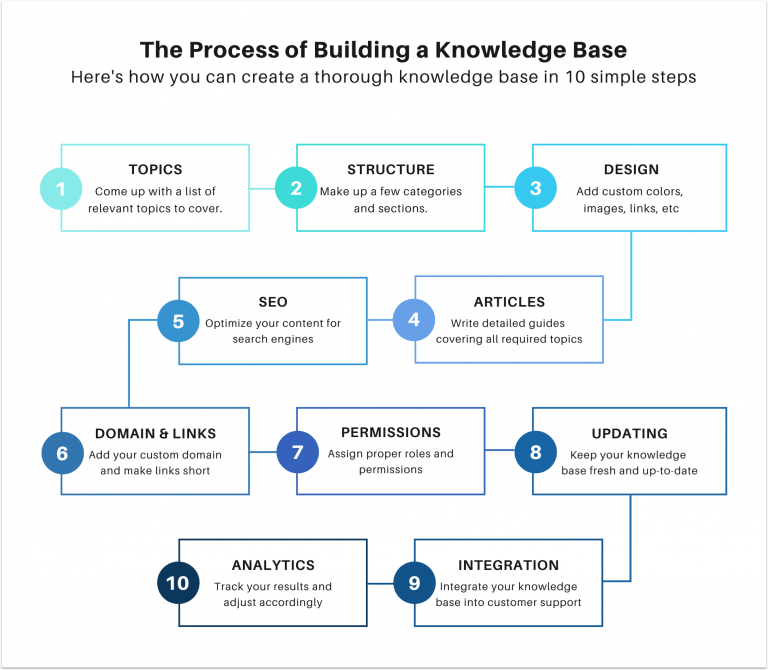
In some of the steps, you can indeed rely on a template to a large extent. In other cases, you will have to create everything from scratch according to the specific traits of your company.
For example, if you want your knowledge base to truly represent your company, you should start with branding. And when we say branding, the first thing that comes to mind is, of course, the logo.

Many software solutions allow you to customize the knowledge base according to your brand colors. After setting the logo, it’s worth taking a few minutes to make the necessary adjustments to get that consistent look and feel throughout your internal documentation.
When you use Archbee for your public docs, you can also customize the look of your docs and add your logo.

With branding out of the way, you should think of categories, topics, and articles that should be customized specifically for your business.
For instance, different policies, regulations, and rules vital for legally protecting your business are so important that they’re usually the first to be incorporated into the internal knowledge base.
As they are full of legalese and often dull, many companies simply download a template and fill it in with the company name and address.
However, that is not the case with Facebook and its Code of Conduct.
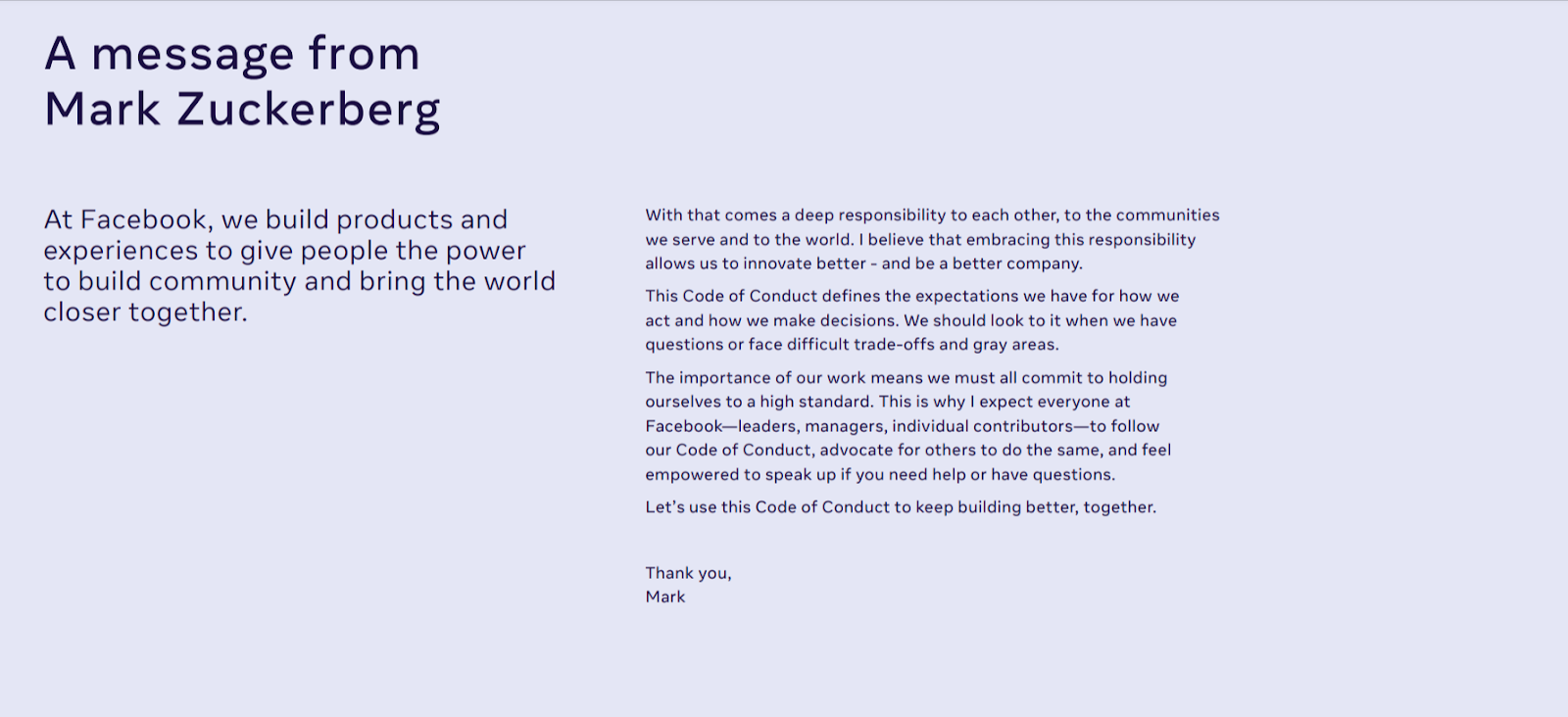
Facebook’s playbook is customized to the tiniest detail to showcase what the company stands for and the rules of engagement.
From the introductory message from Mark Zuckerberg, through mission statements, and up to the section on diversity, all the content is highly customized to meet Facebook’s needs.
For example, in big corporations like Facebook, confidentiality is something that is taken seriously, as a breach of confidentiality can jeopardize their business and reputation.
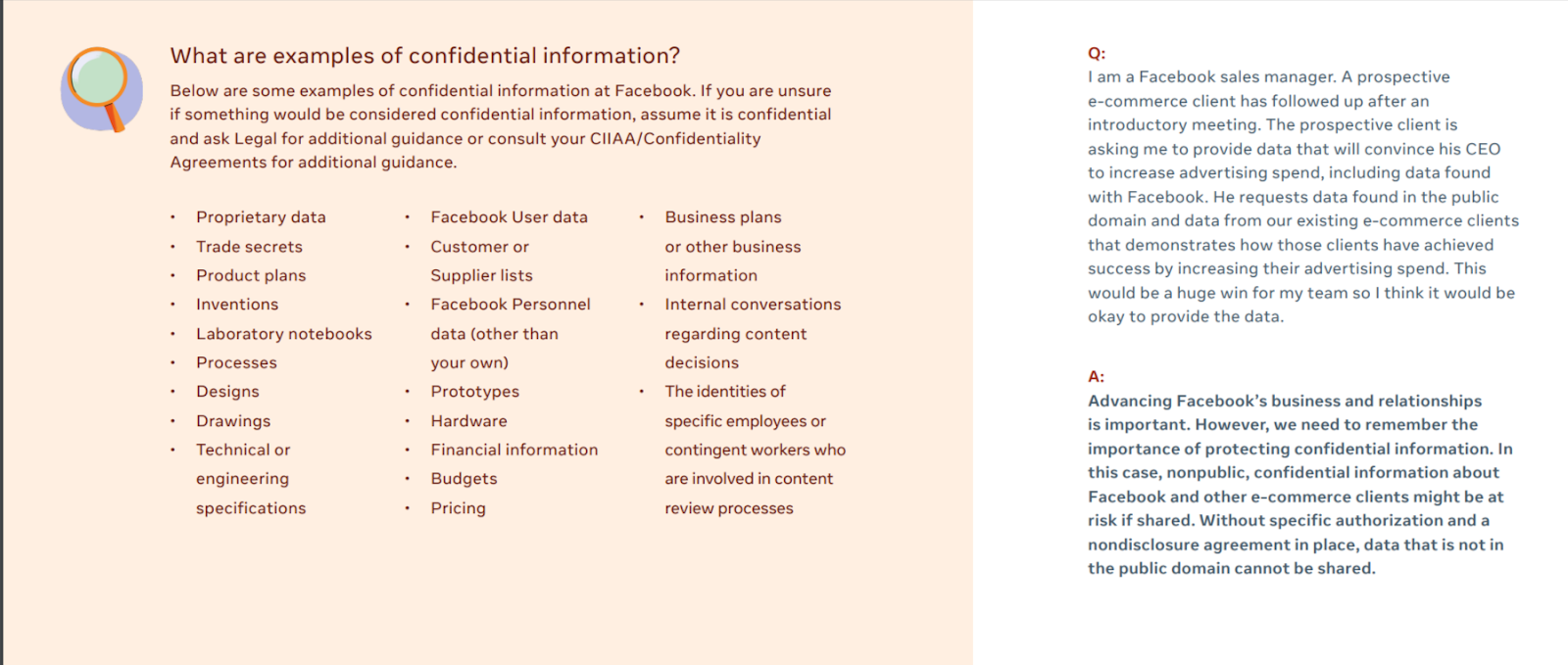
That’s why, on three pages, they list exactly what falls under the category of confidential information and state the consequences of the data confidentiality violation.
When it comes to knowledge management systems, there is no universal solution. Every company has its demands and preferences.
The rule of thumb here is: the more you customize your knowledge base, the better it will serve your employees in their everyday work. And that is something worth considering.
Keeping Knowledge Management Systems Secure
These days your company’s data is more at risk than ever.
Since the pandemic took hold and many companies started to work remotely, cyberattacks have become a real threat.
A survey conducted by Deloitte shows that 47% of employees are susceptible to phishing scams while working remotely. More than half a million people worldwide fell victim to cyberattacks over a period of only three months in 2020.

Although these statistics apply to employees working remotely, those who work in offices are also in danger of cybersecurity attacks.
So how can companies protect their knowledge management systems that often include sensitive documents?
An easy first step is to choose a KM solution that offers advanced cyber security.
For example, Archbee is a cloud-based solution that has a daily backup and can restore your data loss within an hour. Additionally, all the documents are encrypted and sent via an HTTPS/SSL protocol to prevent hackers from attacking them.
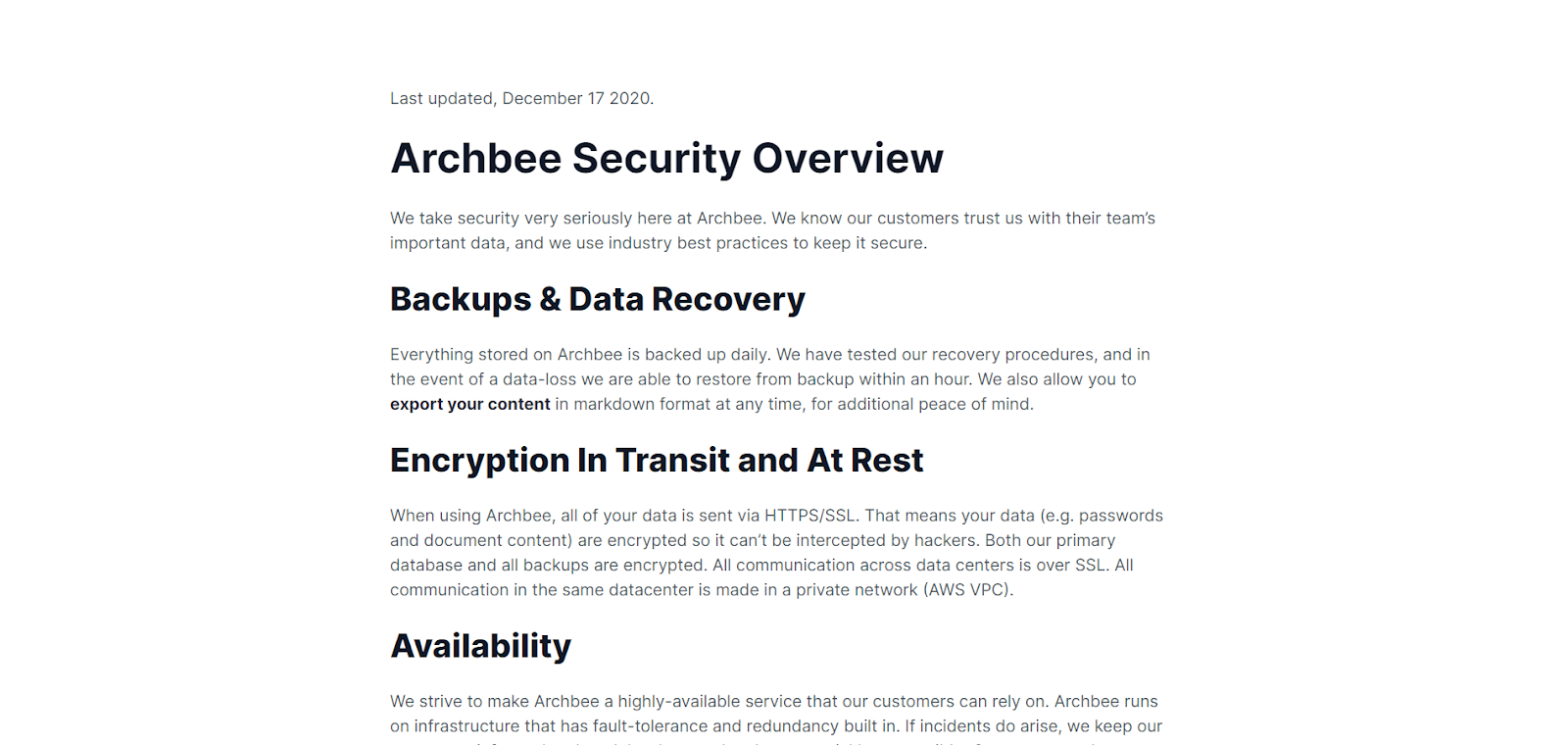
Also, when choosing software, you should keep a close eye on the service provider. For instance, Archbee uses Amazon Web Services, known for the highest privacy and data security standards.
So if you see that the software you are considering uses Amazon AWS, you can be sure that your internal documentation will be protected from malicious cyber attacks.

You can also emphasize that all employees must use antivirus programs and secure WiFi networks, and protect online accounts with passwords and two-factor authentication.
After all, when it comes to securing your documentation, every one of these safety measures, no matter how small, can play a big part in protecting your company from potential security disasters.
Conclusion
In this article, we brought you nine challenges that can stand in the way of building a successful knowledge management system.
Some are easier to overcome, and others require more time and effort.
If you take them into account now and follow the tips and tricks we have outlined here, the chances are that the new knowledge management system you are about to launch will soon become a valuable source of information that everyone will appreciate.



.png)







